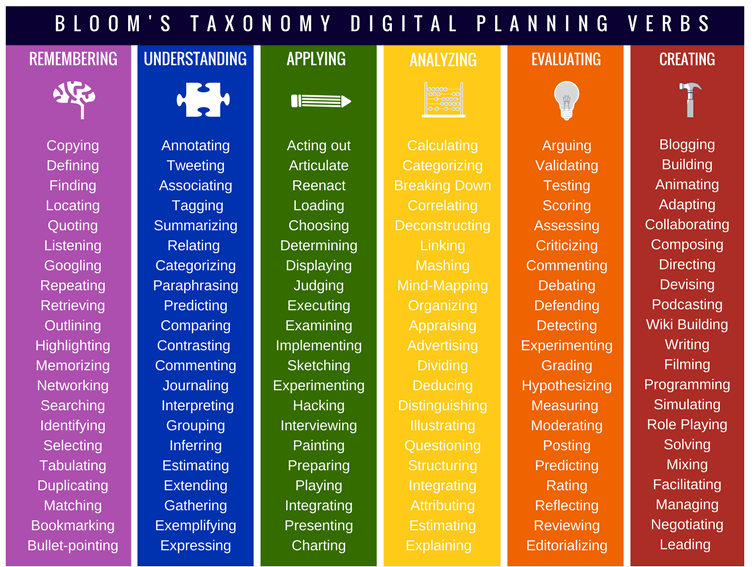
How Can You Use Bloom’s Taxonomy In The Classroom?
by Terry Heick
Bloom’s Taxonomy is a powerful teaching and learning tool that can help you shape nearly everything that happens in your classroom.
Why you would want to do this is another conversation, though I will say that, in brief, Bloom’s places the focus on student thinking and observable outcomes, and that is useful in formal learning contexts.
That said, Bloom’s Taxonomy is simply one way to think about thinking and learning and so no, it shouldn’t ‘shape everything you do.’ By choosing one thing, you, by definition, don’t choose many others. I’ve yet to see a single, universal framing of everything that works everywhere for everyone—likely because that’s a silly idea.
How To Use Bloom’s Taxonomy In The Classroom
So then, how should you use Bloom’s Taxonomy in the classroom? Applying this model isn’t always an entirely seamless thing, if for not other reason than most ‘parts’ of learning (e.g., curriculum maps, pacing guides, lesson templates, tests, behavior charts, report card, etc.) aren’t ‘made for’ it.
As I explained in What Is Bloom’s Taxonomy? A Definition For Teachers, Bloom’s Taxonomy is simply a way of thinking about thinking—a framework. Consider how a ‘diet’ is a way of framing food to achieve a specific purpose, whether that purpose is improved sleep, weight loss, added muscle, or any other number of factors, a ‘diet’ ‘frames food’ around a certain way of thinking and a specific purpose. While not exactly functioning the same way a diet does, Bloom’s Taxonomy does provide a kind of structure to think about learning and achieve specific goals.
Below, I’ve listed 50 ways to use Bloom’s Taxonomy in the classroom. Of course, there are literally hundreds, if not thousands. Some would likely require their own post to explain sufficiently, so I don’t expect this to function as a how-to guide but rather a kind of brainstorming to demonstrate not just the power of Bloom’s Taxonomy, but the utility of learning frameworks in general—including the TeachThought Learning Taxonomy.
50 Ways To Use Bloom’s Taxonomy in The Classroom
1. Map curriculum
2. Frame data about learning (wouldn’t necessarily have to be assessment data, but could be)
3. Design an assessment
4. Improve an assessment
5. Design a ‘What now?” after-assessment assignment
5. Personalize learning
6. Support students in self-directed learning
7. Guide inquiry-based learning
8. Create ‘if you finish your work early’ assignments
9. Frame letter grades
10. Create content-based team-building games
11. Provide learning feedback
12. Promote meta-cognition in students
13. Revise writing with students—or to help them to revise it themselves
14. Use it to group students (one group per Bloom’s level, for example, then rotating based on some criteria or timing)
15. Create literature circles
16. Learning reflection journals
17. Visualize student progress over a period of time
18. Create tiered assignments (what I call a ‘Bloom’s Spiral)
19. Frame choice boards
20. Content-based bell ringers
21. Smarter exit slips
22. Guide research projects
23. Simplify an assessment as a response to intervention
24. Increase the complexity of an assessment to challenge high-achieving students
25. Create question stems (to learn or demonstrate learning)
26. Model a skill/competency via given Bloom’s level
27. Frame a mini-lesson
28. Structure a write-around (pass around one sheet of paper per Bloom’s Level, then ask students to write and pass freely based on a given topic or learning target)
29. Differentiate instruction
30. Guide your own teacher professional development (e.g. self-assessing the strength of your own understanding on a given topic)
31. Skim and respond to current events
32. Summarize a reading passage
33. Structure a formal classroom discussion
34. Evaluate the winner in a debate
35. Create a Combination Learning blend
36. Organize your own digital teaching materials on Google Drive
37. Evaluate the historical significance of a person or event (by evaluating the relative complexity of a person’s ‘performance’ or the ‘weight’ of an event)
38. Create a digital scavenger hunt (You can find our Bloom’s Digital Taxonomy cards here.)
39. Curate student digital portfolio artifacts
40. Refine and improve questions
41. Help students create their own reading response prompts
42. Combine with a KWL chart before, during, or after a lesson
43. Create a digital citizenship campaign
44. Self-monitor own understanding of a target over the course of a lesson/unit (e.g.,s students would create a visualization of their own understanding at certain checkpoints)
45. Provide ‘sync points’ in Sync Teaching
46. Brainstorm essay topics or ‘angles’
47. Frame the evolution of an argument (in writing or speaking—during pre-writing stages, for example)
48. Plan a podcast or video series around a topic (moving ‘up and down’ Bloom’s Taxonomy)
49. Help support students during student-led conferences
50. Brainstorm ideas for project-based learning
You can explore some of our Bloom’s Taxonomy resources, and look for an upcoming course from TeachThought University on the effective use of Bloom’s Taxonomy in your classroom.
50 Ways To Use Bloom’s Taxonomy in The Classroom
